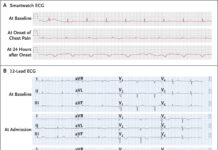Case Presentation
A 15-year-old Lebanese boy presented with a jellyfish sting, which happened while he was on a beach in the Arabian Gulf on 27 September 2018.
On examination, the doctors found that his left forearm was swollen and very tense because of cellulitis. Moreover, there was a large reddish patch on the dorsal aspect of the forearm where the sting had occurred. The skin was cold compared to the right side, and the capillary refill was very slow. The boy was able to extend his fingers. However, there was no palpable radial or ulnar pulse on the affected side.
Investigations
The doctors performed a portable Doppler scan which revealed a good signal in the brachial artery. However, there was no signal at the level of the radial and ulnar arteries. This finding suggested that the jellyfish venom had caused a blockage in the lower arm arteries of the affected limb, resulting in compromised blood flow and tissue damage.
Management
For the management of compartment syndrome, the doctors took informed consent. They performed decompression fasciotomy, where they made an incision on the left forearm. Both the superficial and deep compartments were incised and explored, revealing all muscle groups to be intact with minimal swelling, along with normal cubital and radial arteries pulses. The doctors left the wound open, and they planned further closure depending on the vascular prognosis of the patient’s arm.
On the second day postoperatively, the patient’s finger perfusion was impaired, and there was no pulse in the mid-forearm. Doctors administered diluted nitroglycerin to the wound directly over the radial artery in an attempt to resolve the arterial spasms. Furthermore, they decompressed the carpal tunnel. The patient was kept in the Pediatric intensive care unit (PICU) for a week on low-molecular-weight heparin (LMWH) and intravenous antibiotics, nitroglycerine, and morphine infusion. The perfusion in the patient’s arm improved over the next few days. Additionally, the Doppler signal started to improve over the radial artery along with the palmar arch and fingers.
On the fifth day, doctors performed surgery to close both forearm and wrist incisions. He was transferred to the regular ward on the day of surgery and was discharged on day 8 in good condition. The doctors advised him to continue LMWH for two more weeks, along with oral antibiotics and pain control medications. He was followed up in the vascular outpatient clinic weekly for four weeks with normal doppler colour flow and a triphasic waveform.
On day 17 post-operatively, doctors performed a nerve conduction velocity (NCV) study which showed reduced amplitudes for the left ulnar and radial nerves. This indicated nerve damage. The patient complained of pain in the left shoulder and elbow, with tenderness, muscle spasms, left elbow flexor weakness, and a limited range of motion at the elbow and wrist joints. His motor function improved after receiving ten sessions of physiotherapy over a period of six weeks.
Discussion
There are more than 100 species of jellyfish known to be dangerous to humans, and treatment depends on various factors, such as the severity of the illness, the type and size of the jellyfish, and the patient’s response.
Jellyfish stings are more common in children because they tend to play in the water. Furthermore, their skin offers less protection due to a thin epidermis and less hair. The reaction to a jellyfish sting can range from mild to life-threatening, depending on the species. The tentacles of jellyfish that have lethal stings contain stinging nematocysts that release venom upon mechanical stimulation. The venom contains toxic peptides, phospholipase A, and histamine-liberating factors. These cause symptoms such as burning, pruritus, and throbbing pain, along with reddening, blistering, and swelling of the skin. Other symptoms can include neurological, cardiovascular, respiratory, rheumatologic, gastrointestinal, renal, and ocular symptoms that may lead to anaphylaxis.
After a jellyfish sting, it is important to immediately decontaminate the skin using vinegar, rubbing alcohol, baking soda, fresh lemon juice, or olive oil. Moreover shaving the skin can remove the remaining nematocysts and control the initial reaction. For venomous box jellyfish stings, immersion in hot water up to 45°C is effective. It is important to avoid freshwater contact and vigorous rubbing, which can lead to further stinging. Topical anaesthetic ointments, antihistamines, or glucocorticoids may be helpful after decontamination. Persistent severe pain may require narcotics, whereas muscle spasms may respond to intravenous diazepam.
Despite the potential danger, there are preventative measures that individuals can take to minimize the risk of jellyfish stings, such as wearing protective clothing and avoiding swimming during jellyfish season.




